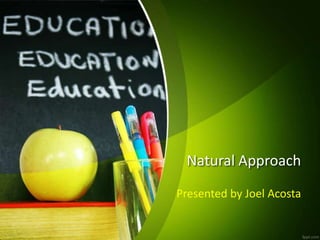
Natural approach
- 1. Natural Approach Presented by Joel Acosta
- 2. Natural Approach • Background • Main representatives • Theories • Definition/concept • Basic Principles • Objectives • Roles of Teacher & Learner • Materials
- 3. Background & Main Representatives It was developed and published as a book by Mr. Stephen Krashen and Mrs. Tracy Terrell in 1983. Mr. Stephen Krashen is a famous linguist. He is currently a professor at University of Southern California. Mrs. Tracy Terrell is an educational theorist and a professor at University of California.
- 4. Background & History Natural Approach believes that adults can still acquire second languages. The ability of language acquisition does not disappear as we grow up. Adults also acquire language by following the principles of Universal Grammar.
- 5. Background & History The different between adult and children acquisition skill is that adults have two things to follow when they learn foreign language: Acquisition and learning. But, children only acquire the languages. In the book, Mr. Krashen and Mrs. Terrell consider their approach as a traditional method.
- 6. Theories The Acquisition-Learning hypothesis • The most basic steps of all in the Krashen’s theory. • It’s the most well known among linguists and language practitioners. • The learner has two ways of learning the second language, which are the acquired system and the learned system.
- 7. Theories The monitor hypothesis • When the learner can check and correct language output. The Natural Order hypothesis • When people acquire language by using grammatical structures in a predictable order.
- 8. Theories The input hypothesis • The acquisition of language is in a predictable order. Everybody have the same steps of learning acquisition.
- 9. The Affective Filter hypothesis • Three kinds of affective or attitudinal were identified: • Motivation: learners with high motivation generally do better. • Self-confident: learners with self-confidence and a good self-image tend to be more successful. • Anxiety: Low personal anxiety and low classroom anxiety are more conducive to second language acquisition.
- 10. Concept or definition Is a language teaching approach which claims that language learning is a reproduction of the way humans naturally acquire their native language.
- 11. "traditional approach to language teaching [because it is] based on the use of language in communicative situations without recourse to the native language." (Richards & Rodgers 2001: 178) "language teaching methods based on observation and interpretation of how learners acquire both first and second languages in non-formal settings." (Richards & Rodgers 2001: 190)
- 12. Basic Principles "Focus of instruction is on communication rather than its form.“ "Speech production comes slowly and is never forced.“ "Early speech goes through natural stages (yes or no response, one- word answers, lists of words, short phrases, complete sentences.)"
- 13. Objectives • To help adults in learning the foreign language naturally. • The learner will be able to pick up the grammar by themselves when they are ready.
- 14. Teacher´s role • Act as an authority in the class • Imitate the first language learning process • Creatively instruct students to do activities that benefit the language learning.
- 15. Learner´s role • Pre-production stage: learners participate in the language activity without having respond. • Early-production stage: learners answer questions, with single words and short phrases. • Speech-emergent stage: learners involve themselves in role plays, games and other activities.
- 16. The Role of Instructional Materials • Make classroom activities as meaningful as possible and promote comprehension and communication. • The primary aim of materials is to promote comprehension and com-munication. • Pictures and other visual aids are essential, because they supply the content for communication • Materials come from the world of realia rather than from textbooks.
- 17. In Class Activities For beginners: Pointing, handing objects, writing or drawing , standing, walking, sitting down For advanced learners: Like listening and reading tasks that learners order pictures, follow written instruction or maps.
- 18. Techniques • Using inputs like pictures, objects • Mime • Body language • Audio-visual aids • Memorizing games
- 19. Strengths & Weaknesses Strengths • This method is very easy. • Reliable as it’s widely used • There’s no grammar instruction in this method. Weaknesses • It takes long time and learner can do only elementary things. • It does not suit for those who do not have much time. • The method rarely concerns about correctness
- 20. Bibliography • Richards, J ; Rodgers, T. “Approaches and Methods in Language Teaching” 5th ed.1989. Melbourne. Cambridge University Press • Celce-Murcia, M. (1991). Language Teaching Approaches. In M. Celce-Murcia (Ed.), Teaching English as a Second or Foreign Language. (pp.3-10). Boston, Massachusetts: Heinle & Heinle.
